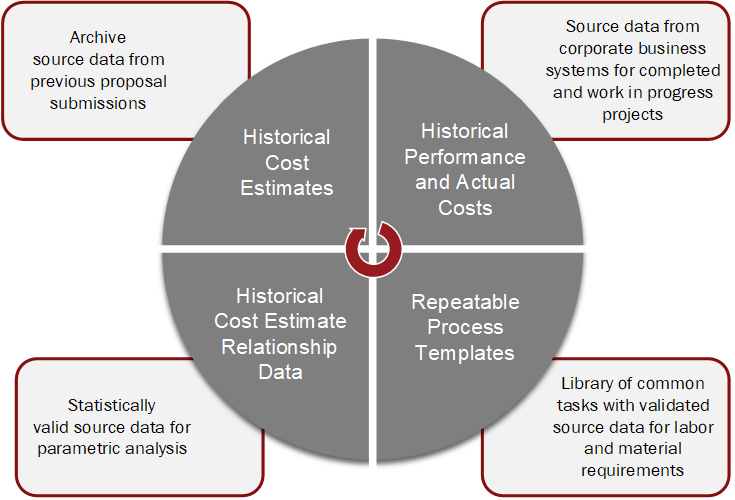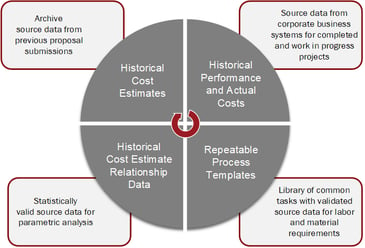A previous blog, Leveraging Closed Loop Cost Estimating, discussed creating a searchable database of reliable source data to help proposal teams produce data driven cost estimates easier and faster. Creating a useful database of historical performance and actual cost data also requires putting some thought into how you organize the data. It helps to have a general framework in mind as you are collecting the data for the database. The intent is to make it easier for proposal teams to search for similar tasks and evaluate whether the similar tasks are relevant for their proposal.
As a reminder, the image below illustrates what a searchable database of reliable source data often includes.

With access to a single database of useful source data, proposal teams can look through their proposal software for similar elements of work, tasks or work packages, resource assignments, or user defined attributes to help them create their cost estimate and document their basis of estimate rationale.
How do you make it easy to search for relevant data?
This is where up front planning for organizing the data can make it easier to locate applicable source data for a proposal. How do different members of the proposal team go about developing their contribution to the proposal submission? Are there common threads of content they use as their basic building blocks?
A typical common thread is the element of work or task description for accomplishing or producing something, often organized into a work breakdown structure (WBS). Since everyone thinks differently, how one person describes or searches for a specific task won’t be the same as the next person. That’s why industry organizations and government agencies create standards such as the MIL-STD 881 for work breakdown structures so there is a common foundation to identify elements of work.
Common foundations also help proposal teams. You may discover other factors that affect the quality of the proposal data and how the teams go about developing the proposal content. Is the proposal process ad-hoc or more structured? Standard frameworks can provide the structure to establish a repeatable proposal development process so it is easier and faster for proposal teams to find relevant source data in their proposal writing software.
What methods are useful for organizing source data so it is easier to search? Here are a few suggestions to help you get started.
Create Templates
Templates can take a variety of forms. The intent is to provide a foundation for proposal teams as well as project control teams that saves time and improves data consistency – particularly in how work elements are named or labeled as well as how resources are identified. Over time this helps different functional users to think in common terms they can use to search and find what they need for their proposal as well as developing a schedule or cost baseline after contract award. This is particularly true when project control teams leverage the proposal schedule and cost estimate at contract award.
One option is to create project templates and global structures. An example is base work breakdown structures for common elements of work your company often performs. The objective is to provide standard coding and naming conventions teams can simply copy and use. Templates can be for a small set of common tasks or they can be a foundation WBS for the entire project. Think about the scope of the data to include in the templates as well. Is it just the WBS content? Depending on the type of work your company normally performs, you may be able to create a set of base project templates that include common core data such as calendars, rates, resource structures, and code structures.
With a basic of estimate software such as BOEMax, another option is to establish a process library. This is an even better approach because for each set of common tasks, a complete set of relevant source data along with narrative information is organized into a named process the proposal teams can search. For each process, you list the tasks that are required to perform a service such as refurbishing a piece of equipment, producing a deliverable part, or completing a construction step such as pouring concrete. The process library in estimate software is perfect for capturing a set of standards for doing specific tasks based on a historical average of actual costs. The resource requirements are defined for each task such as the labor skill mix, number of labor hours, and bill of material quantities. The driving factor for the different types of tasks are also identified. For example, the number of pieces of equipment that need to be serviced, the number of deliverable parts, or square footage. The proposal team can apply a quantity or complexity factor as needed when they copy the data into their proposal project.
Another form of a template is to define a list of common resource roles that are assigned to the detail resources required to perform work on a project. Examples of resource roles include, “Project Manager,” “Systems Engineer,” or “Electrical Engineer” that reflect the skill mix appropriate to your business environment. That way the proposal teams can include the resource role in the task search criteria.
Establish Standard Terms for Common Tasks
Templates can help you accomplish this because you are creating a foundation of reusable proposal content that proposal teams can copy into their project. Templates are only one part of the picture. It could be that templates only get you so far because of the nature of the work your company performs.
One option is to establish a library of common terms to name or describe tasks. Socialize the list with your proposal teams as well as your project control personnel. Publish it so it is easy for everyone to access and reference. You may be able to take advantage of published industry or government standards to help define these so you can quickly create a list for internal use.
The hard part is getting the people who create proposal content and develop a project’s schedule and cost baseline to use those terms. It takes discipline. Using standard terms for work tasks is often the last thing on someone’s mind when they have a looming deadline. Recurring training can be helpful. Explain why using common terms is important, helps the proposal teams search for the data they need, improves the quality of proposals submissions, and improves the usefulness of the data for the entire project lifecycle.
Add User Defined Attributes
What do we mean by “user defined attributes?” Attributes are code fields, flags, or other identifiers you add to code structures such as the WBS, work packages or tasks, or resources that help to further qualify the work element, task, or resource. They become additional elements proposal teams can use to search and locate similar work effort.
This is where doing your homework pays off. What search criteria would be helpful for proposal teams to locate relevant elements of work or tasks? This will be unique to your business environment. Is there a way for you categorize, group, or label work elements? For example, perhaps you perform work for commercial and government entities. For government customers, you may need to include a group of tasks along with the applicable resources to handle the agency’s regulatory requirements. You could use attribute fields to help proposal teams quickly find the applicable set of tasks that would need to be included in a proposal.
Defining a list of common resource roles mentioned earlier is an example of a resource attribute. While a proposal may identify a named resource in the cost estimate, the assigned resource role further qualifies that resource. There are number of benefits to using qualifiers. In addition to facilitating search queries for a proposal, they are useful for sorting, filtering, grouping, producing reports, and performing analysis. Resource attributes can be particularly useful for managing resource capacity and demand.
Taking advantage of user defined attributes also requires discipline. They need to be populated to be useful. Again, that’s where templates can help to some degree as does recurring training emphasizing why they are important. Consider ways to help make it easier for people to do the right things using templates, base data people can copy, reference materials, or work instructions.
Interested in learning more about how you can leverage a searchable database of cost estimate and historical data for your proposal teams? Give us a call today to schedule a demo of our bidding software.


